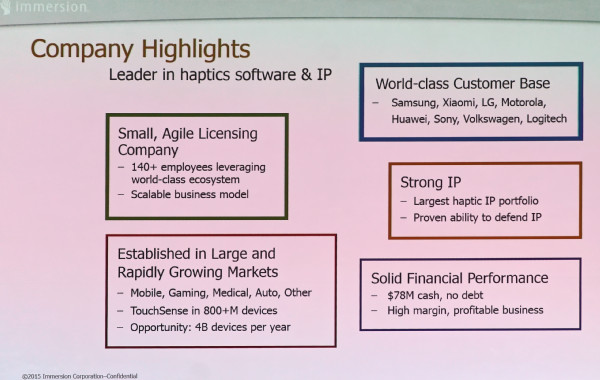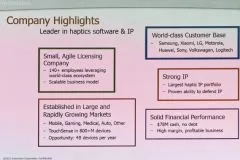The next section was entitled “Evolution of the Immersive Experience” and covered a range of technologies.
Immersion is a company that is “about haptics” which it sees as the feedback for touch experiences. The speaker from the company was Paul Norris, CFO of Immersion, which is established in haptics IP.
Adding haptics increases the richness of communications and the realism of games and other experiences. Norris claimed that with haptic feedback users are more productive, faster and more accurate in many data applications.
Touch is a very powerful sense and there’s a reason we talk about “feelings” and “being touched”. Norris moved quickly through the technology. The company has software to control the motors that are used to create the haptic effects and allow user interface interaction. SDKs, tools and APIs are provided to make adding haptics to applications simpler.
The firm also has a creation/distribution and haptic playback service. Markets are mainly mobility, gaming, wearables, medical, automotive and content consumption.
Immersion has a wide range of partners and customers and claims to have almost 2,000 patents worldwide, including some “very foundational” patents. It’s IP strategy is to “fill the white space”. It works with customers at different levels according to how much involvement is wanted and needed.

Sony and Microsoft licensed the “rumble” technology for gaming from Immersion and in automotive there is a lot of interest in keeping drivers’ concentration on the road, with haptic feedback through the steering wheel.
More than 50% of the company’s revenues come from mobile, with gaming at 25%. 98% of revenue is from licensing, with just over half in variable royalties and just less than half in fixed licences. Automotive is just 5% now, but is expected to grow. Mobile has been a good market, but there is still a lot of potential for growth. Wearables could be very interesting and sometimes using a screen may not be appropriate.
Content consumption is interesting, including video, mobile advertising and social media apps. There is a team in Immersion looking at this area although this business is really in a pilot phase. The film “Homeland” had a trailer that makes a smartphone vibrate when a bomb explodes and this increased the click through rate and impact of the media.
Over 15,000 apps on the Android platform use haptics, including Angry Birds Friends and Google has added a special area for “games you can feel”.
In social media, there are ideas such as heartbeats that act like touch-based emoticons. Revenue is around $60 million and the company is profitable, with plenty of cash and reserves.
In response to a question, Norris said that the addition of haptics by Apple in its wearables and MacBooks is really positive. Immersive’s customers are responding to this, although Apple is not a current customer of Immersive, but, as Norris said, “We have an ip position”.
If Apple opens up an API, that will also help Immersion as those using haptics may well want to have the feature on Android as well as iPhones, Norris believes.

